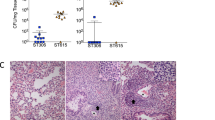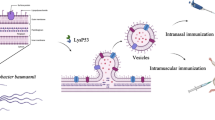Abstract
Encapsulated and nontypableHaemophilus influenzae isolates recovered from pediatric patients and healthy children were examined for their ability to lyse and to release phage after mitomycin C induction. Lysis occurred in 16 out of 58 isolates tested for lysogeny. The serotype b capsule ofH. influenzae does not exhibit an inhibitory effect on either cell lysis or the ability of the cells to become lysogenized. Electron microscopic examination revealed the presence of tailed particles in 11 lysates. The tailed particles belong to two morphological groups (A and B) according to the classification of Bradley [Bacteriol. Rev. 31:230–314]. None of the phages was able to produce plaques when tested on a large number of strains. However, five lysates exhibited killing properties involving several nontypableH. influenzae strains. This effect sedimented with the bacteriophage after centrifugation. All the phages recovered fromH. influenzae isolates in this study appeared to be genetically defective.
Similar content being viewed by others
Literature Cited
Bendler W, Goodgal SH (1968) Prophage S2 mutants inHaemophilus influenzae: a technique for their production and isolation. Science 162:464–465
Bernheimer HP, Tiraby JG (1976) Inhibition of phage infection by pneumococcus capsule. Virology 73:308–309
Boling ME, Allison DP, Setlow JK (1973) Bacteriophage ofHaemophilus influenzae III. Morphology, DNA homology and immunity properties of HPIc1, S2 and the defective bacteriophage from strain Rd. J Virol 11:585–591
Bradley DE (1967) Ultrastructure of bacteriophages and bacteriocins. Bacteriol Rev 31:230–314
Goodman SD, Scocca JJ (1989) Nucleotide sequence and expression of the gene for the site-specific integration protein from bacteriophage HP1 ofHaemophilus influenzae. J Bacteriol 171:4232–4240
Gromkova R, Goodgal S (1974) On the role of restriction enzymes ofHaemophilus in transformation and transfection. In: Grell RF (ed) Mechanism in recombination. New York: Plenum Press, pp 209–215
Gromkova R, Goodgal S (1977) Studies on the transforming activity of ampicillin and tetracycline resistance markers inHaemophilus. In: Portolés A, López R, Espinosa M (eds) Modern trends in bacterial transformation and transfection. Amsterdam: North-Holland Publishing Company, pp 299–306
Gromkova R, Bendler J, Goodgal S (1973) Restriction and modification of bacteriophage S2 inHaemophilus influenzae. J Bacteriol 114:1151–1157
Harm W, Rupert CS (1963) Infection of transformable cells ofHaemophilus influenzae by bacteriophage and bacteriophage DNA. Z Vererbungsl 94:336–348
Kilian M (1976) A taxonomic study of the genusHaemophilus, with the proposal of a new species. J Gen Microbiol 93:9–62
Notani NK, Setlow JK (1974) Mechanism of bacterial transformation and transfection. Prog Nucleic Acid Res Mol Biol 14:39–100
O'Callaghan CH, Morris A, Kirby SM, Shringler A (1972). Novel method for detection ofβ-lactamase by using a chromogenic cephalosporin substrate. Antimicrob Agents Chemother 1:283–288
Pieckarowicz A, Kalinowska J (1974). Host specificity of DNA inHaemophilus influenzae: similarity between host-specificity types ofHaemophilus influenzae Re and Rf. J Gen Microbiol 81:405–411
Pittman M (1931). Variation and type specificity of the bacterial speciesHaemophilus influenzae. J Exp Med 53:471–492
Samuels J, Clarke JK (1969). New bacteriophage ofHaemophilus influenzae. J Virol 4:797–798
Seaman E, Tarmy E, Marmur J (1964). Inducible phages ofBacillus subtilis. Biochemistry 3:607–613
Stachura I, McKinley FW, Leidy G, Alexander HE (1969). Incomplete bacteriophage-like particles in ultraviolet-irradiatedHaemophilus. J Bacteriol 98:818–820
Stuy JH (1978). On the nature of nontypableHaemophilus influenzae. Antonie van Leeuwenhoek 44:367–376
Waldman AS, Goodman SD, Scocca JJ (1987). Nucleotide sequences and properties of the sites involved in lysogenic insertion of the bacteriophage HPIc1 genome into theHaemophilus influenzae chromosome. J Bacteriol 169:238–246
Author information
Authors and Affiliations
Rights and permissions
About this article
Cite this article
Muthivhi, T.N., Gromkova, R.C., Sharp, P.E. et al. Lysogeny in encapsulated and nontypable strains ofHaemophilus influenzae . Current Microbiology 22, 173–179 (1991). https://doi.org/10.1007/BF02092130
Issue Date:
DOI: https://doi.org/10.1007/BF02092130




